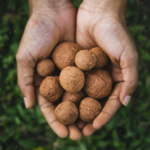
Green Sweat Bees are Toronto’s official bee!
SEED BALLS
Seeds balls are a fun (and easy!) way to plant native wildflower seeds, which provide excellent sources of nectar for native pollinators, such as Green Sweat Bees!
Adult assistance is recommended for this activity because of the use of red clay.
Materials:
- Sprinkling of wildflower seeds
- 2 parts dry red clay
- Bowl for mixing
- 3 parts soil
- 1 part water
- Stick for stirring
- 1 part worm castings* (or other compost)
- Garden gloves (optional)
- Directions:
Directions:
- Mix the wildflower seeds with the soil and worm castings. *Worm castings are made by worms – they are full of all the nutrients that new seeds need to grow!
- Add the dry clay and mix well. BE VERY CAREFUL TO NOT BREATHE IN THE RED CLAY DUST!
- Gradually add water until the mixture becomes firm and clumps together.
- Pinch small amounts of the mix and roll between the palms of your hands until smooth and round. Each seed ball should be approximately 1-3 cm in diameter.
- Place seed balls onto a flat surface to harden undisturbed for 24 hours.
- Throw your seed balls into garden beds or in “empty” fields and parking lots and see what grows!
Go to PAGE 3 to read about Black Swallowtail Butterflies and learn about their magnificent lifecycle!

